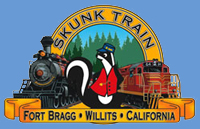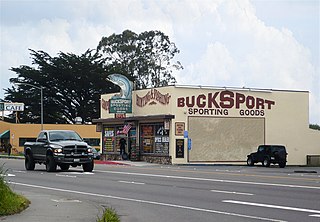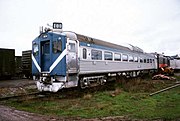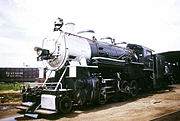
The California Western Railroad, AKA Mendocino Railway, popularly called the Skunk Train, is a rail freight and heritage railroad transport railway in Mendocino County, California, United States, running from the railroad's headquarters in the coastal town of Fort Bragg to the interchange with the Northwestern Pacific Railroad at Willits.

The Sumpter Valley Railway, or Sumpter Valley Railroad, is a 3 ft narrow gauge heritage railroad located in Baker County, in the U.S. state of Oregon. Built on a right-of-way used by the original railway of the same name, it carries excursion trains on a roughly 5-mile (8.0 km) route between McEwen and Sumpter. The railroad has two steam locomotives and several other pieces of rolling stock. Passenger excursion trains operate on weekends and holidays from Memorial Day through the end of September.

The Yreka Western Railroad Company is a shortline railroad operating freight trains between the Union Pacific Railroad interchange at Montague and the City of Yreka, California. Railmark Holdings acquired the Yreka Western Railroad in 2017.

The McCloud Railway was a class III railroad operated around Mount Shasta, California. It began operations on July 1, 1992, when it took over operations from the McCloud River Railroad. The MCR was incorporated on April 21, 1992.

The California, Shasta and Eastern Railway was a 15 miles (24 km) shortline railroad which operated, for nearly 40 years, between Anderson and Bella Vista, California with no greater aspirations then being a glorified mill spur. Briefly around 1906 however, the road basked in the limelight of the mighty E.H. Harriman who considered, and then discarded, the idea of incorporating it into one of his "paper" railroads projected through the region.

A forest railway, forest tram, timber line, logging railway or logging railroad is a mode of railway transport which is used for forestry tasks, primarily the transportation of felled logs to sawmills or railway stations.
Disston is an unincorporated community in Lane County, Oregon, United States, southeast of Cottage Grove where Brice Creek and Layng Creek join to form the Row River. It is about a mile west of the Umpqua National Forest. Its post office opened in 1906 and ran until 1974. Cranston Jones—the first postmaster—was also one of the founders of the first sawmill in Disston and the name of the town came from the famous Disston saws.

Robert Dollar Company No. 3 is an operating steam locomotive on the Niles Canyon Railway in California. It is notable for having been the last wood-burning locomotive built for an American company.

Bucksport was a town in Humboldt County, California. The original location was 2.5 miles (4 km) southwest of downtown Eureka, on Humboldt Bay about 5 miles (8 km) northeast of entrance. at an elevation of 16 feet (4.9 m). Prior to American settlement a Wiyot village named Kucuwalik stood here.
Culp Creek is an unincorporated community in Lane County, Oregon, United States, southeast of Cottage Grove on the Row River. It lies on Row River Road between Dorena and Disston.
The Caspar, South Fork & Eastern Railroad provided transportation for the Caspar Lumber Company in Mendocino County, California. The railroad operated the first steam locomotive on the coast of Mendocino County in 1875. Caspar Lumber Company lands became Jackson Demonstration State Forest in 1955, named for Caspar Lumber Company founder, Jacob Green Jackson.

The Fort Bragg and Southeastern Railroad was formed by Atchison, Topeka and Santa Fe Railway as a consolidation of logging railways extending inland from Albion, California on the coast of Mendocino County. The railroad and its predecessors operated from August 1, 1885 to January 16, 1930. The line was merged into the regional Northwestern Pacific Railroad in 1907; but planned physical connection was never completed.
Southern Pacific Transportation Company formed the Oregon and Eureka Railroad Company in 1903 in an agreement to use logging railroads as part of a line connecting Humboldt County (California) sawmills with the national rail network. Northwestern Pacific Railroad offered service over the route from 1911 through 1933. The northern 6-mile (9.7 km) of the line remained in use as a Hammond Lumber Company logging branch until 1948.

Row River National Recreation Trail is a rails to trails conversion in the U.S. state of Oregon. It follows the Row River for 16.2 miles (26.1 km) between Cottage Grove and Culp Creek, passing by Dorena Lake, and provides access to many forest trails of Umpqua National Forest.
Wildwood is an unincorporated community in Lane County, Oregon, United States. It is located between Culp Creek and Disston on the former line of the Oregon, Pacific and Eastern Railway (OP&E), about 16 miles southeast of Cottage Grove.
Mendocino Lumber Company operated a sawmill on Big River near the town of Mendocino, California. The sawmill began operation in 1853 as the Redwood Lumber Manufacturing Company, and changed ownership several times before cutting its final logs in 1938. The sawmill site became part of the Big River Unit of Mendocino Headlands State Park where a few features of the mill and its associated forest railway are still visible along the longest undeveloped estuary in northern California.

McCloud Railway No. 18 is a 2-8-2 "Mikado" type steam locomotive built by Baldwin Locomotive Works. The locomotive was purchased new by the McCloud River Railway Company in 1914 as a standalone purchase. No. 18 was bought by the Yreka Western Railroad in 1956 and bought back by the McCloud in 1998. It was restored to operation in McCloud during 1998 and operated there until it was sold in 2005 to Virginia and Truckee Railroad.

The Mosquito and Coal Creek logging railroad was a 10 miles long private logging railway with a gauge of 3 foot (914 mm) near Eufaula, Washington.

The Oregon, California and Eastern Railway (OC&E) was a 64-mile (103 km) rail line between Klamath Falls and Bly in the U.S. state of Oregon. After 70 years of bringing logs from nearby forests to local sawmills, the former railroad right of way was converted to the OC&E Woods Line State Trail.

McCloud Railway No. 19, also known as Yreka Western No. 19, or Oregon, Pacific and Eastern No. 19, is a preserved 2-8-2 "Mikado" type steam locomotive in the United States that worked on the Caddo and Choctaw Railroad, United States Smelting, Refining and Mining Company McCloud River Railroad, Yreka Western Railroad, and the Oregon, Pacific, and Eastern Railway. It was purchased new from the Baldwin Locomotive Works (BLW) in 1915. Shortly after retirement, the engine operated on the Yreka Western before being moved up to Cottage Grove, Oregon to run on the OP&E. In the late 1980s, #19 was sent back down to Yreka, California to run on the YW. In April of 1994, the engine returned to McCloud, California to run a series of excursions on the McCloud, Railway. It has since been used in the films Emperor of the North Pole, Bound for Glory, and Stand By Me. As of 2022, No. 19 is being restored at the Age of Steam Roundhouse in Sugarcreek, Ohio.



















